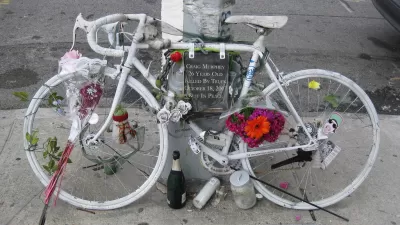Traffic fatalities in California have been rising since 2010, rising to 3,104 in 2013 after decreasing from 2006 to 2010. Experts point to several specific reasons for the increase; one of the most prominent may be in your hand right now.
The economy may seem like the likely cause for the reversal in traffic crashes, particularly with the increase coinciding closely with the end of the Great Recession, but Tony Bizjak, transportation reporter for the The Sacramento Bee, writes that the recovery helps explain the increase in the number of vehicles and vehicle-miles-traveled, but not necessarily fatalities.
In some ways, the connection seems obvious: More people on the roads means more fatal encounters. But state highway officials say that doesn’t have to be the case. Having more cars on the roads doesn’t always lead to more crashes. In some instances, crowded roads can make driving safer by forcing motorists to slow down and pay more attention. (For instance, crash rates on rural roads are higher than on urban streets.)
Distracted driving, a cause célèbre of former U.S. Secretary of Transportation Ray LaHood, seems like another likely reason. But Chris Cochran of the state Office of Traffic Safety, [a division of the California State Transportation Agency] "said it is uncertain how big a role distracted driving plays in crashes because drivers often don’t admit after a crash that they were on their phones rather than watching the road."
Even if motorists were to admit to using their phones, California's laws do not reflect today's technology. The 2007 cell phone law that bans "drivers using hand-held cellphones to talk and text" doesn't account for all the other uses of smart phones, as Cochran explains.
“Before, you could talk or text, and that was it. Now with a half-million apps, people practically run their lives off their cellphones. They check their stocks. They GPS. They play Candy Crush. They are watching movies.”
Is it time for new legislation to address the many uses of smart phones that can result in distracted driving?
A state appellate court last year ruled that a CHP officer was wrong to ticket a Fresno driver for consulting a map on his smartphone. The law also is silent on whether a driver can check Facebook while driving.
Caltrans pointed to another 'lifestyle' trend: "drugged-driving crashes are on the upswing," writes Bizjak. "Some of that may stem from older drivers taking prescription drugs that affect their driving ability. Marijuana use also is likely up, safety officials say."
Also under 'lifestyle' is the increase in motorcycle and bicycle riding, particularly among older males, that has caused an increase in fatalities from prior years.
Whatever the reason, the result is that "(s)ince 2010, the death toll has ticked up annually, hitting 3,104 in 2013," notes Bizjak. That's still lower than 2006, when "4,300 people were killed on roads and highways," but higher than 2010, when 2,739 died. Officials expect the upward trend "to continue when 2014 numbers are finalized."
Hat tip: MTC-ABAG Library
FULL STORY: Traffic deaths climbing in California – Is there a fix?

Planetizen Federal Action Tracker
A weekly monitor of how Trump’s orders and actions are impacting planners and planning in America.

Maui's Vacation Rental Debate Turns Ugly
Verbal attacks, misinformation campaigns and fistfights plague a high-stakes debate to convert thousands of vacation rentals into long-term housing.

San Francisco Suspends Traffic Calming Amidst Record Deaths
Citing “a challenging fiscal landscape,” the city will cease the program on the heels of 42 traffic deaths, including 24 pedestrians.

Amtrak Rolls Out New Orleans to Alabama “Mardi Gras” Train
The new service will operate morning and evening departures between Mobile and New Orleans.

The Subversive Car-Free Guide to Trump's Great American Road Trip
Car-free ways to access Chicagoland’s best tourist attractions.

San Antonio and Austin are Fusing Into one Massive Megaregion
The region spanning the two central Texas cities is growing fast, posing challenges for local infrastructure and water supplies.
Urban Design for Planners 1: Software Tools
This six-course series explores essential urban design concepts using open source software and equips planners with the tools they need to participate fully in the urban design process.
Planning for Universal Design
Learn the tools for implementing Universal Design in planning regulations.
Heyer Gruel & Associates PA
JM Goldson LLC
Custer County Colorado
City of Camden Redevelopment Agency
City of Astoria
Transportation Research & Education Center (TREC) at Portland State University
Jefferson Parish Government
Camden Redevelopment Agency
City of Claremont



























